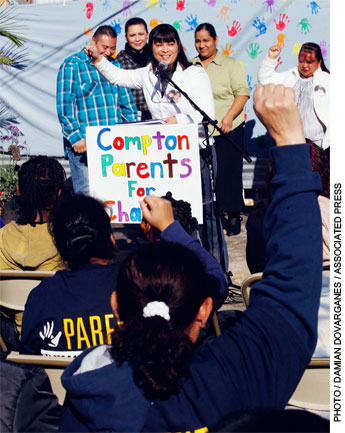 One year ago, the Wall Street Journal dubbed 2011 “the year of school choice,” opining that “this year is shaping up as the best for reformers in a very long time.” Such quotes were bound to circulate among education reformers and give traditional opponents of school choice, such as teachers unions, heartburn. Thirteen states enacted new programs that allow K–12 students to choose a public or private school instead of attending their assigned school, and similar bills were under consideration in more than two dozen states.
One year ago, the Wall Street Journal dubbed 2011 “the year of school choice,” opining that “this year is shaping up as the best for reformers in a very long time.” Such quotes were bound to circulate among education reformers and give traditional opponents of school choice, such as teachers unions, heartburn. Thirteen states enacted new programs that allow K–12 students to choose a public or private school instead of attending their assigned school, and similar bills were under consideration in more than two dozen states.
With so much activity, school choice moved from the margins of education reform debates and became the headline. In January 2012, Washington Post education reporter Michael Alison Chandler said school choice has become “a mantra of 21st-century education reform,” citing policies across the country that have traditional public schools competing for students alongside charter schools and private schools. “It took us 20 years to pass the first 20 private school–choice programs in America and in the 21st year we passed 7 new programs,” says Scott Jensen with the American Federation for Children (AFC), a school-choice advocacy group based in Washington, D.C. “So we went from passing, on average, one each year, to seven in one fell swoop.” Programs enacted in 2011 include
• a tax-credit scholarship program in North Carolina
• Arizona’s education savings account system for K–12 students
• Maine’s new charter school law, which brings the total number of states, along with the District of Columbia, with charter schools to 42
• a voucher program in Indiana with broad eligibility rules.
School-choice laws also passed in Wisconsin, Washington, D.C, Oklahoma, and Ohio, some as new reforms and some that expanded existing options.
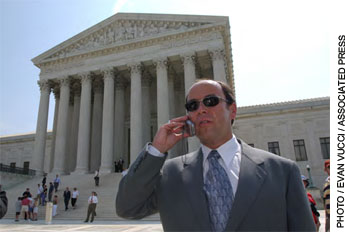
Now, in 2012, it is still not clear whether the legislative advance of school-choice bills in 2011 made more education options available or simply ushered in a bevy of new lawsuits. Maybe both. Many of the laws, including Indiana’s voucher program, Arizona’s savings accounts, and a new voucher program in Douglas County, Colorado, were challenged in court shortly after passage. These legal challenges stalled reform and kept the school choice movement fighting for a clear identity. Is school choice just for certain student groups, like low-income children, or can it actually change the public school system?
For some laws, such as Indiana’s, a legal challenge did not prevent thousands of students from participating in the program’s first year. In other cases, as with Colorado’s voucher initiative, courts shut down the program just as the school year began, leaving hundreds of students uncertain as to whether they could remain at their new schools.
“Legal challenges to school-choice programs have become as inevitable and painful as death and taxes,” says Clint Bolick, vice president for litigation at the Phoenix-based Goldwater Institute. Bolick has defended school-choice laws around the country, from Arizona to Ohio to the U.S. Supreme Court.
“We should view legal challenges as a good sign that we are accomplishing something,” he says.
Perhaps 2011 was an unusual year for school reform only because of the number of school-choice programs enacted, which was significant by any measure, but not because students swarmed to the new programs (Indiana is a notable exception). We must wait to see which laws will survive legal challenges and whether students will enroll while judges consider the programs’ constitutionality. While school-choice laws arrived en masse in 2011, and the laws that passed are bolder than ever, lawsuits keep the systemic change reformers hope for just out of reach.
Vouchers
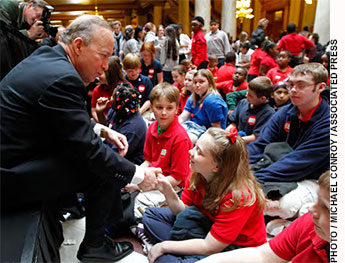
On May 5, 2011, Indiana governor Mitch Daniels signed into law the most inclusive voucher program in American history. Indiana’s “Choice Scholarships” were designed with broad eligibility rules that include middle-class and low-income students.
Voucher programs are often designed with “means testing” in mind, which specifies the income level for eligible students’ families. Typically, means-tested programs limit student eligibility to students from families with household income levels at or below a specified percentage of the poverty line.
The voucher amounts and household income levels for Indiana’s program are on a sliding scale. For example, a household of two parents with a combined income of $42,643 and two children would receive vouchers worth 90 percent of the state’s per-pupil funding figure (or approximately $4,500). As long as household income does not exceed $63,964, the two children in this household could still receive scholarships worth 50 percent of the state’s per-pupil amount.
“Indiana’s program is significant because it bridges the divide between advocates of means-tested choice and advocates of universal choice,” says Bolick.

Indiana education commissioner Tony Bennett said he “fully expected litigation,” and the state teachers union filed a legal challenge in July 2011. Over the next several months, the lawsuit progressed through Indiana’s court system, and in March 2012, the Indiana State Supreme Court announced it would hear the case. As this article went to press, no date had been set.
Bennett’s expectations were likely shaped by the history of voucher programs in states such as Ohio, Florida, and Arizona. In those states, teachers unions and other education associations challenged and—in Florida and Arizona—overturned vouchers. In 2002, the U.S. Supreme Court ruled in Zelman v. Simmons-Harris (concerning Ohio’s program) that vouchers do not violate the U.S. Constitution, but the decision hasn’t prevented courtroom battles from taking place from state to state over the past decade.
Despite the uncertainty surrounding Indiana’s legal challenge, 3,919 students from 185 Indiana school districts signed up in the program’s first year. This marks the largest inaugural enrollment in a voucher program in U.S. history. More than 250 private schools have been approved by the department to receive voucher students. Even with the inclusive eligibility rules, the Indiana Department of Education reports that 85 percent of new voucher students qualify for the federal free or reduced-priced lunch program. This indicates that these students are from families that would not otherwise be able to access private schools.
The school board in Douglas County, Colorado, located about 30 miles south of Denver, also created a voucher program in 2011. The American Civil Liberties Union and Americans United for the Separation of Church and State immediately challenged the program in court, and Denver district court judge Michael A Martinez issued a permanent injunction in August. Douglas County’s program is unique because board members designed it as a district initiative, rather than working with state lawmakers to draft a bill. The system would have awarded up to 500 students vouchers worth $4,575.
Leslie Hiner, vice president at the Friedman Foundation for Educational Choice, says, “Those who oppose parental choice, they’ll always fight back, but that’s OK.” The foundation has monitored school-choice developments in the U.S. since 1996, and Hiner says Colorado’s program is evidence of a shift in opinion among education leaders.
“The realization was that the only thing that really matters is that every child has an opportunity to learn. If you keep that out in front of you at all times, then it’s easy for a public school board in Colorado to pass a voucher because they want all kids to learn,” she says.
Education Savings Accounts
In 2011, Arizona enacted a system of education savings accounts, called Empowerment Scholarship Accounts (ESAs), for students with special needs (see sidebar). Families can use the money for private school tuition, or choose from a list of approved education expenses that includes textbooks and online classes. By September 2011, 75 students had completed their applications and enrolled in the program. Participation doubled in December when the department reopened the application window.
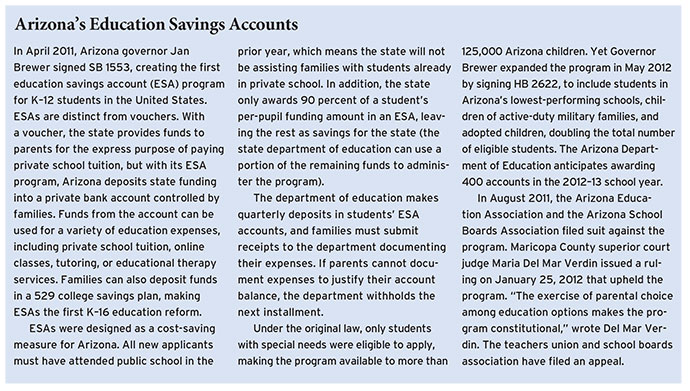 Bolick says ESAs are the future of school choice. “ESAs are a real game changer,” he says. “They have the potential to completely change the delivery of educational services while at the same time surviving legal challenges that have forestalled voucher programs.” Bolick and the Goldwater Institute, along with Arizona schools superintendent John Huppenthal and the Institute for Justice, a civil liberties law firm, are defending the program from a lawsuit filed by the Arizona teachers union and state school boards association.
Bolick says ESAs are the future of school choice. “ESAs are a real game changer,” he says. “They have the potential to completely change the delivery of educational services while at the same time surviving legal challenges that have forestalled voucher programs.” Bolick and the Goldwater Institute, along with Arizona schools superintendent John Huppenthal and the Institute for Justice, a civil liberties law firm, are defending the program from a lawsuit filed by the Arizona teachers union and state school boards association.
“Empowerment Scholarship Accounts are just another form of these vouchers trying to bypass the law,” Arizona Education Association president Andrew Morrill told the local ABC News affiliate. The Arizona Supreme Court ruled vouchers unconstitutional in 2009, citing state constitutional provisions prohibiting public funding for private or religious purposes.
“In a state rich in both public and private choice, parents overwhelmingly choose public schools,” he said.
Yet ESAs continue to push the envelope of education reform, consistent with the theme of 2011’s other school-choice programs. If Indiana’s vouchers are notable for how many students are eligible and Colorado’s program because district leaders designed it, ESAs are remarkable for the variety of allowable uses. ESAs are distinct from vouchers because parents can use the funds for different education services, while vouchers can only be used for private school tuition. The program adds a new element to debates over education reform: Can families use state funds to customize a child’s education?
Arizona has a charter school law, three tax-credit scholarship programs, and an open enrollment law that allows students to choose from schools across the state, so the question of whether parents should be able to choose a school for their child is settled. The question has become whether the system can successfully enable parents to shape a child’s entire schooling experience.
The Parent Trigger

Among the school choice-based education reforms enacted in recent years, the Parent Trigger Act may be the most drastic. As passed in California, Texas, and Mississippi, the Trigger Act allows parents to petition to convert a school to a charter school, close the school, or replace school leadership. At least half of the parents with students in a school must sign the petition. Though three states have passed laws since 2010, most of the “trigger” activity occurred in California in 2011.
“The basic reason why it happened when it did was that things got so bad in Los Angeles that parents began looking around and recognized that no one is coming to their rescue,” says Ben Austin of Parent Revolution, the Los Angeles–based organization leading the movement (see “Not Your Mother’s PTA,” features, Winter 2012).
“If things are going to change, we are going to have to be ‘Superman,’” he says, referring to the title of the 2010 documentary film Waiting for Superman, which drew attention to the long waiting lists at many charter schools. Austin’s group is “unambiguously” opposed to vouchers, which means student- and parentcentric reforms are coming from both sides of the political spectrum. Austin, who worked in the White House for President Bill Clinton, says many on his staff are politically left of center.
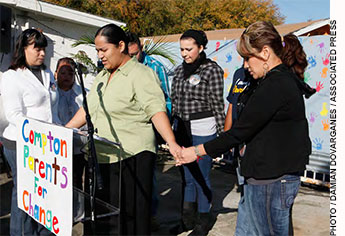
The first parents to petition for reform did so at McKinley Elementary School in December 2010, and the process lasted well into 2011. Fewer than 20 miles south of Los Angeles, McKinley is located in the Compton Unified School District, one of the lowest-achieving school districts in the state. In February 2011, district officials rejected the parents’ petition, and parents responded by filing and ultimately losing a lawsuit against the district. While a new charter school was not allowed to move into McKinley, the Celerity Educational Group opened Celerity Sirius Charter School near McKinley in September 2011.
As many as 20 states considered trigger legislation in the 2011 and 2012 legislative sessions, but the new bills struggled to find support. In 2012, bills failed in Arizona and Florida, two states that, historically, have been receptive to school-choice programs (the two states have nearly a dozen choice laws between them). Louisiana governor Bobby Jindal signed a parent trigger law in April 2012 as part of a package of reforms that included a significant expansion of the state’s voucher program.
As state lawmakers continue their debate, some contend the program makes for exciting headlines but will not lead to effective school reform.
“The parent trigger reform is a dead end and makes no sense,” says Washington Post education columnist Jay Mathews. He suggests that parents, no matter how committed to the cause, don’t have the time or political savvy to lead effective school change. “It’s an interesting idea that sounds exciting on its face,” he says, “but it’s not going anywhere.”
Austin would disagree and points to California’s example. “Parents became informed about a nuanced public policy. With that power comes real responsibility,” he says. More than a dozen local Parent Revolution groups have formed in California, and in June 2011, Time magazine reported Parent Revolution advocates were at work as far away as Buffalo, New York.
Expansions
As new programs appeared in 2011, some existing programs saw expansion.
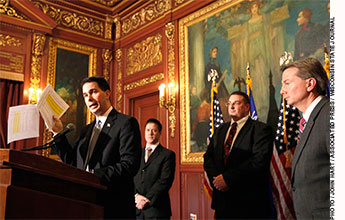
In Milwaukee, Wisconsin, Governor Scott Walker removed the cap on the city’s voucher program. Students in the program receive vouchers worth up to $6,442 to attend a private school of choice. Milwaukee’s voucher program is the oldest in the United States.
The 2011 expansion also extended voucher eligibility to all low-income district students and those next door in Racine. The Racine school board considered legal action over the program, though none has been filed to date. The means test for Milwaukee and Racine students is also on a sliding scale, similar to Indiana’s Choice Scholarships. Students from families with household incomes up to 300 percent of the federal poverty line (slightly less than $70,000 for a family of four) are eligible, making these programs more examples of inclusive school-choice programs created last year. In Milwaukee, more than 23,000 students were participating as of September 2011, with more than 200 Racine students enrolled in the expansion.
Tax Credits
Like vouchers, tax-credit scholarships also allow students access to private schools, though these scholarships depend on private contributions and the state tax credits that follow. Individuals and/or corporations contribute to scholarship organizations, which then award private school scholarships to qualifying students. Donors receive a credit on their taxes for their contribution, with credit amounts usually capped at certain limits.
In 2011, Oklahoma and North Carolina enacted scholarship tax-credit programs, and Arizona expanded its existing law in 2012 after a veto in 2011. Oklahoma’s program is means-tested, and students from families with household incomes of up to 300 percent of the federal poverty line are eligible to participate. This program arrived one year after Oklahoma lawmakers passed a voucher program for students with special needs, and it should come as no surprise that districts filed suit to stop the vouchers (a little surprising, though, that districts sued the students and their parents, instead of the state).
North Carolina passed a “personal use” tax-credit program in 2011, which allows families to receive a credit for education expenses. Under the law, families of students with special needs can take a credit of up to $6,000 annually for expenses such as private school tuition and therapy services. The North Carolina Department of Public Instruction estimates that more than 120,000 students and their families may be eligible to make use of the credits.
“This is a large leap forward for a movement that a lot of people thought was dying on the vine,” says the AFC’s Jensen. “It’d been quite a few years since we’d had a tax credit pass for a family’s educational expenses, and $6,000 changes a family’s ability to choose a school.”
Governor Jan Brewer vetoed an expansion to Arizona’s 15-year-old scholarship tax-credit program in 2011, citing a negative impact on the state budget. Bill sponsors, including Republican state senator Rick Murphy and representative Debbie Lesko, revised the measure in 2012 to specify that any students receiving scholarships under the proposed expansion would be new scholarship recipients switching from public school to private school.
Under the new bill, individual (as opposed to corporate) donations to scholarships would be capped at $1,000 ($2,000 for married couples), double the previous limit. Brewer signed the expansion in 2012.
Does Passing Laws Equal Success?
Success implementing new school-choice laws in 2011 must be considered state by state. Students in Arizona and Indiana have more options but await rulings from the court system. In Colorado, many families are left wondering what to do next. Wisconsin parents in Racine must look over their shoulders for any sign of future litigation.
Legal issues aside, will enough students participate in choice-based reforms to change the status quo?
“My general view,” says the Post’s Mathews, “is that the voucher path is a dead end because we are never going to have nearly enough spaces in private schools for the kids who need it.
“No matter how much the laws change, I don’t see them ever leading to a place where there are enough spaces,” he says. Historically, voucher initiatives have struggled to gain support, says Mathews, because of persistent Democratic Party and educator opposition.
Voucher programs have long been considered a “Holy Grail” of sorts among school-choice advocates because they allow students to use state funds for a private school. But in 2011, reformers set ambitious goals for how many options could be afforded to parents, so even if participation is light, the range of choices that parents and children have in education should cause everyone to think twice about how public schools have been operating. Programs like Arizona’s provide parents with more options than vouchers. Likewise, California’s “trigger” law has radical implications, by giving parents the power to act without waiting for reform to happen to them.
“We are living in a revolutionary moment where the public as well as policymakers are open to thinking in new ways about issues in a way that hasn’t happened in a generation,” says Parent Revolution’s Austin.
Furman University professor Paul Thomas says that choice-based reforms became law in impressive numbers in 2011, but these reforms lack an agenda for comprehensive change.
“One thing that is telling to me about school-choice advocacy is that the claims and the goals are constantly shifting,” says Thomas, author of Parental Choice? A Critical Reconsideration of Choice and the Debate about Choice. “The school-choice movement has always been an ideology movement,” he says.
Others insist that, until recently, only a few choice programs had passed into law, so we should expect the results to be small and scattered.
“The reality is that we’ve had very small expansions in the use of market forces, so, not surprisingly, we’ve had modest effects from choice programs,” writes Jay P. Greene, head of the Department of Education Reform at the University of Arkansas, in Why America Needs School Choice (a book that arrived in the midst of the 2011 activity).
“Programs tend to include relatively few students,” he said.
The Friedman Foundation’s Hiner says legislation and litigation are only the beginning. “Keep in mind that the goal is not to pass legislation. The goal is to enact a program that you can nurture and grow well into the future so that you can serve as many children as need a different type of education,” she says.
Tipping Point
School-choice laws took great strides in 2011, both in the number of programs that succeeded across states and also in the size and scope of the adopted programs. Yet education associations and teachers unions wasted no time in challenging the laws in court, as has been the case for school-choice reforms for the past 20 years. In almost every instance, school-choice advocates had little time to celebrate before looking for an attorney.
Some, like the teachers unions, contend that choice programs exist in isolation from mainstream public school reforms and point to limited participation rates. And others say choice advocates have not convinced people of the programs’ effectiveness.
“Since choice is not really very popular, I don’t think the public is for it,” says Furman’s Thomas.
Either because of public opposition, lawsuits, or the modest scope of voucher and tax-credit scholarship laws, only some 200,000 students nationwide attend private schools through choice systems, a paltry figure compared to the 50 million students in public schools across the United States.
Nevertheless, the school-choice laws that passed in 2011 were a departure from previous reforms in both size and scope. From Wisconsin to California, more students were included in the new laws, and the laws gave them more options.
Parent Revolution’s Austin says lawmakers are considering ideas today that in the not-so-distant past would have been considered outrageous.
“What normal people care about and what policymakers are beginning to care about is the very simple idea of giving parents real power over the educational destiny of their own children,” he says.
Jonathan Butcher is education director for the Goldwater Institute.
This article appeared in the Winter 2013 issue of Education Next. Suggested citation format:
Butcher, J. (2013). School Choice Marches Forward. Education Next, 13(1), 20-27.


